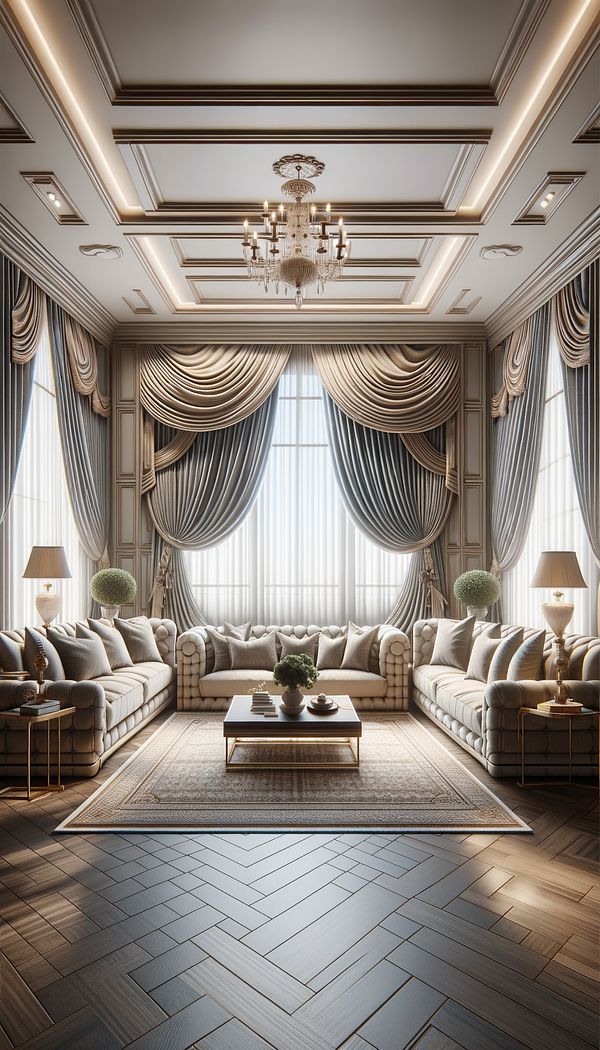What is Swag?
An ornamental drapery or curtain draped in a curve between two points.
Description
In the realm of interior design, swag refers to an ornamental drapery or curtain that is draped elegantly in a curve between two points. This decorative technique adds a touch of elegance and a classical aesthetic to a space. Swags can be made from various materials, including fabric, foliage, or floral elements, depending on the design context and the desired ambiance of the room.
Swags are often used in combination with other window treatments such as valances, curtains, and blinds, to create a layered and cohesive look. They can be tailored to fit the design style of any room, from traditional to contemporary, by adjusting the fabric type, color, pattern, and the way they are draped. Custom-designed swags can add a personal touch and serve as a focal point in a room’s decor.
In addition to window treatments, swags can also be used as decorative elements in other areas of a room. For example, they might adorn the edge of a table in a dining room or be used as part of a decorative arrangement on a mantelpiece. This versatility makes swags a popular choice among interior designers and decorators for adding a luxurious and refined touch to various spaces.
Usage
Swags are most commonly applied as part of window treatments in living rooms, dining rooms, and bedrooms to add an element of sophistication and charm. They can also be incorporated into event decorations, such as at weddings or gala events, to enhance the visual appeal of the space. Professional interior designers may customize swags for clients seeking an upscale and elegant look, ensuring the fabric choice, color, and design align with the overall decor theme of the space.
FAQs
-
Can swags be used in modern interior designs?
Yes, swags can be incorporated into modern interior designs by selecting materials and colors that complement the contemporary aesthetic. Choosing simple, sleek fabrics and minimal draping can integrate swags seamlessly into a modern decor theme.
-
Are swags suitable for all window sizes?
Swags are versatile and can be tailored to fit various window sizes and shapes. The key is customizing the length and fullness of the swag to match the dimensions and style of the window for a balanced look.
-
How do you maintain and clean swags?
The maintenance and cleaning of swags depend on the fabric and material used. Many fabric swags can be gently vacuumed or spot cleaned. Some may require professional cleaning, especially if made of delicate materials or intricately designed.
Practical Application
When incorporating swags into your interior design, consider the room's overall theme and choose fabrics and colors that complement the existing decor. For a more dramatic effect, use lush, rich fabrics with deep colors and textures. To achieve a cohesive look, coordinate the swag's material and color with other textile elements in the room, such as upholstery, pillows, and rugs. Experiment with different draping styles to find the one that best suits the space and reflects your personal style.
-
Decorative Techniques322 articles
-
Window Treatments65 articles
-
Decorating Principles & Elements330 articles
-
Textiles & Upholstery252 articles
-
VintageVintage refers to items, especially furniture and decor, from a previous era that have a sense of history and timeless appeal.
-
ChandelierA chandelier is a decorative ceiling-mounted light fixture.
-
MarquetryMarquetry is the art of applying pieces of veneer to a structure to form decorative patterns, designs, or pictures.
-
Back OrderA back order is an order for an item that is temporarily out of stock.
-
VitrineA vitrine is a glass display cabinet designed to showcase and protect objects or collections.
